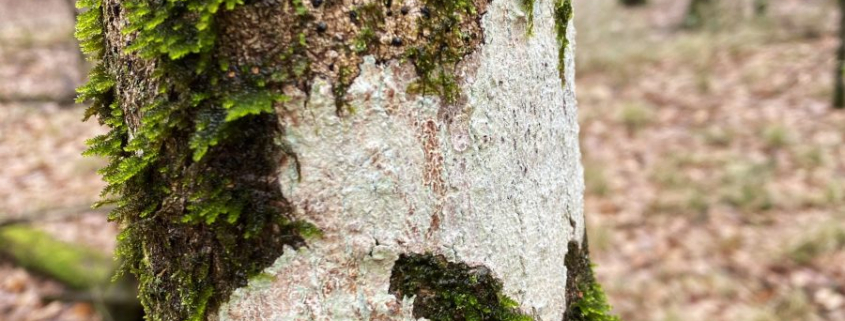Mid-Winter Moss, Lichen, and Fungi Domain at the Goldsmith-Schiffman Wildlife Sanctuary
January 31, 2023 I visited Huntsville, Alabama’s Goldsmith-Schiffman Wildlife Sanctuary early afternoon following a night of steady rain. Saturated forest and field, streams and the Flint River running full, and deep overcast gave the Sanctuary an air of solemn spirituality. This Post offers observations, reflections, and photographs relevant to the lichens, mosses, and fungi I encountered.
Some people have no conception of the exquisite beauty, magic, wonder, and awe of the presumed lesser things of Nature, like lichens, fungi, and mosses. Aldo Leopold, mid-20th century conservationist extraordinaire, offered timeless wisdom, to which I turn often:
The last word in ignorance is the man who says of an animal or plant, “What good is it?” If the land mechanism as a whole is good, then every part is good, whether we understand it or not. If the biota, in the course of aeons, has built something we like but do not understand, then who but a fool would discard seemingly useless parts? To keep every cog and wheel is the first precaution of intelligent tinkering.
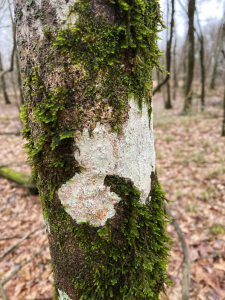
Who would not be entranced by the pure beauty of a beech trunk, thoroughly wetted by the overnight stem flow, draped with moss and painted with crustose lichen?
Exquisite Mosses
Gray and dessicated in summer dry periods, the exquisite moss luxuriously carpeted both standing live and dead trees.

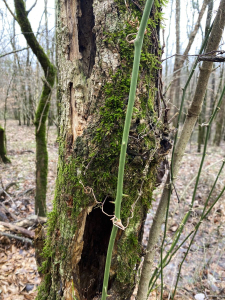
Life abounds across the seasons…and across every surface above ground. Mosses dominate bark surfaces generally from five feet down, where deep shade and more saturated air prevails in summer. Our native mosses flourish on mild winter days…as well as wet summer periods. I recall hiking the coastal rainforests of the Pacific Northwest and southeast Alaska, where thick moss drapes entire trees, enabled by constant moisture and cooler growing seasons.
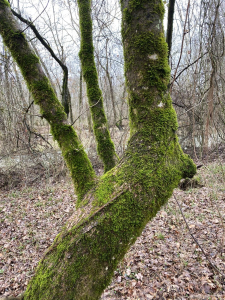
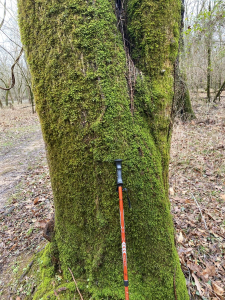
The mosses of northern Alabama’s forests prefer elevated media, whether downed woody debris or boulders, rock ledges, or stumps. The leafy forest floor generally discourages moss, my assumption of cause being the rapid and continuous seasonal turnover of leaves and litter. Micro-organisms, insects, grubs, and other critters densely populate this biologically active re-incorporation zone. I believe the mosses prefer a more stable environment. Another factor may be that the decomposers and consumers in the litter find stationary mosses attempting to colonize forest litter quite digestible.

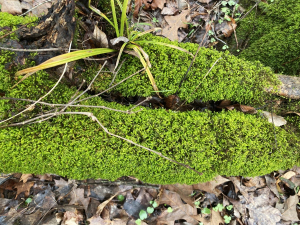
I recorded this 2:29 video to visit in real time with the mosses:
I could go on and on with moss-draped trunks, but I must bring the portfolio to closure. I call the trunk draperies as moss tree skirts. If you have a better term or scientifically accurate descriptor, please let me hear from you. Until then, I shall stick with moss tree skirts.
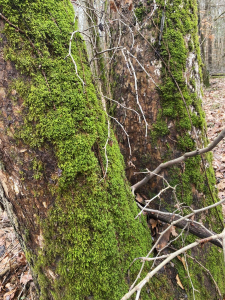
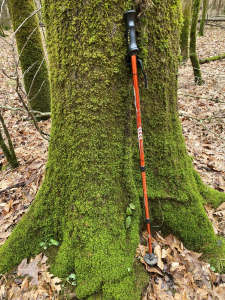
A final regal skirt carries a train that reaches onto the mineral soil apron surrounding the base.
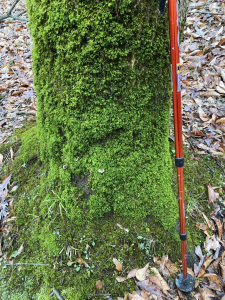
Hallelujah to the magnificent moss draperies that adorn our north Alabama forests, especially in our moisture-enriched riparian hardwood forests!
Likin’ the Lichens!
Okay, I can’t resist playing with the word lichen. So many people have abused my predilection for proper English by observing that they are really likin’ this organism! Well, truth be told, I am the one most frequently abusing our language via deliberate puns and what I call grandpa humor. So, blame the corny subtitle on me. I do in fact like and appreciate the two horizontal lichen stripes on this yellow poplar along the Flint River.
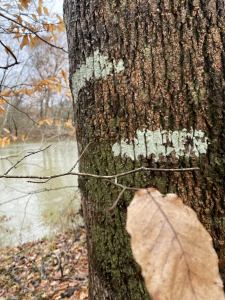
Mosaics of unfathomable beauty…lichens and mosses patterned intricately on the wet bark of American beeches.
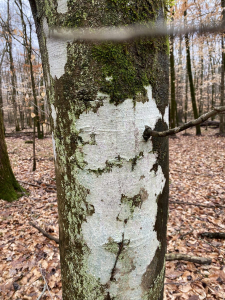
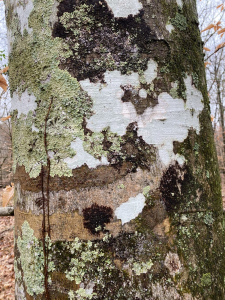
Author Bill Bryson observed this of lichens:
Consider the Lichen. Lichens are just about the hardiest visible organisms on Earth, but the least ambitious.
I deeply admire Bryson’s writing of outdoor adventures in our modern world. However, I can’t accept his lichen wisdom.
Online definition of ambition:
Having or showing a strong desire and determination to succeed
What organism so wildly successful at colonizing such inhospitable surfaces as bare rock and smooth vertical beech bark could be judged to be absent ambition? What does a lichen care about ambition? Unfailingly successful, lichens could conquer virtually any lifeless new surface exposed following a blistering wildfire or volcanic eruption. Who needs ambition when you can eke sustainable life from a seemingly sterile substrate?
Albert Einstein abhorred attributing such human tendencies as ambition to Nature:
I have never imputed to Nature a purpose or a goal, or anything that could be understood as anthropomorphic. What I see in Nature is a magnificent structure that we can comprehend only very imperfectly, and that must fill a thinking person with a feeling of humility. This is a genuinely religious feeling that has nothing to do with mysticism.
I think da Vinci would have commended lichens, having said:
Simplicity is the ultimate sophistication.
Artistic simplicity–Nature’s purpose is not to please our eyes, yet she excels at lifting us with her beauty, magic, wonder, awe, and inspiration. I’m really likin’ these lichens…instruments encouraging human fulfillment.
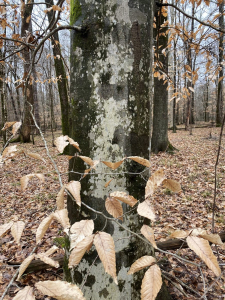
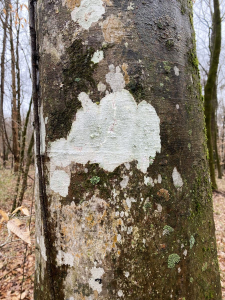
A final frame that requires no weak and feeble narrative.
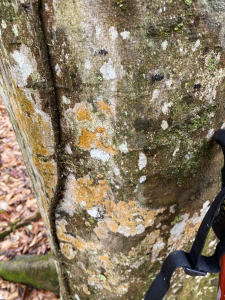
Lichens alone do not populate the surfaces of trees.
Fabulous Fungi
I knew the fungi during my undergraduate days as a subset of the plant kingdom. Shortly thereafter (perhaps the year I earned my forestry BS), those who ruled the life classification world awarded fungi a kingdom to call their own. I also learned fungi in courses on tree pathology. Consider Dutch elm disease, chestnut blight, Fomes annosus (root rot) of white pine, beech-bark disease, heart rot of living trees, and others too numerous to list. Fungi were pathogens for those of us learning how to maximize timber value from the forests we would manage. I opened my own eyes to a broader view beyond those days of restricted educational focus, restricting my look then at the perceived malevolent fungal agents of tree diseases. Don’t we all, mercifully, adopt a broader view of all dimensions of life…our own and the organisms sharing planet Earth with us!
Here is a sampling of the ubiquitous fungi hosted by dead and down woody debris. In contrast to the disease organisms, these benevolent fungi are saprophytes consuming dead cellulose and lignin. Hypoxylon canker of oak, a crust fungus commonly found on branches that have fallen to the forest floor, consumes only dead wood. I would have identified it as a lichen had not iNaturalist, backed by Mushrooms of the Gulf Coast States, declared its true identity. I remain a dedicated lifelong learner.
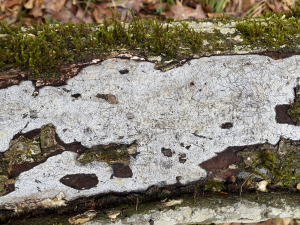
Crowded parchment fungus and brown-toothed crust fungus added color and diversity to the fungi I photographed. Such a rich kingdom of life occupying the forest floor, which even as it is fascinating is also easy to avoid our notice. I have learned to look, see, appreciate, and understand what most people either ignore or simply fail to look.
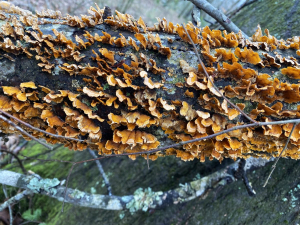
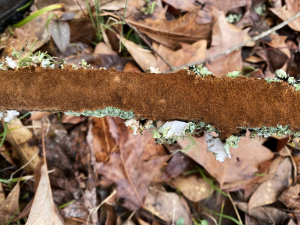
Jelly fungi are even harder to spot. However, to the wild edible mushroom enthusiast, our local amber jellies are a tasty treat…a culinary delight. I collected a handful in a plastic bag, enjoying them the next morning in a breakfast omelette. Don’t try this at home unless you are 100 percent certain of identity.
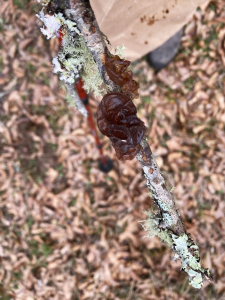
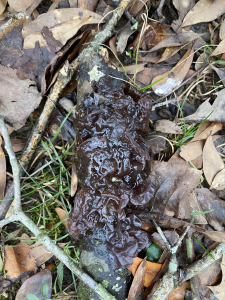
I remain a student of traditional forestry, still enamored by tall, fat commercial grade select hardwood species. Having been trained and weaned on timber production, I can’t help myself. However, I’ve grown far beyond the bounds of my original forestry (timber) focus, venturing into dimensions of forestry and natural resources management to encompass all of Nature’s beauty, magic, wonder, awe, and inspiration!
Thoughts and Reflections
I offer these observations:
- If the land mechanism as a whole is good, then every part is good, whether we understand it or not. Aldo Leopold
- Miracles of Nature lie everywhere in plain sight!
- Always a sucker for big, tall, straight trees, I’ve matured to appreciate the endless beauty, magic, wonder, and awe of lichens, mosses, and fungi.
Inhale and absorb Nature’s elixir. May Nature Inspire, Inform, and Reward you!
Note: All blog post images created & photographed by Stephen B. Jones unless otherwise noted. Please circulate images with photo credit: “©2023 Steve Jones, Great Blue Heron LLC. All Rights Reserved.”
Another Note: If you came to this post via a Facebook posting or by an another route, please sign up now (no cost… no obligation) to receive my Blog Post email alerts: http://eepurl.com/cKLJdL
And a Third: I am available for Nature-Inspired Speaking, Writing, and Consulting — contact me at steve.jones.0524@gmail.com
Reminder of my Personal and Professional Purpose, Passion, and Cause
If only more of us viewed our precious environment through the filters I employ. If only my mission and vision could be multiplied untold orders of magnitude:
Mission: Employ writing and speaking to educate, inspire, and enable readers and listeners to understand, appreciate, and enjoy Nature… and accept and practice Earth Stewardship.
Vision:
- People of all ages will pay greater attention to and engage more regularly with Nature… and will accept and practice informed and responsible Earth Stewardship.
- They will see their relationship to our natural world with new eyes… and will understand more clearly their Earth home.
Tagline/Motto: Steve (Great Blue Heron) encourages and seeks a better tomorrow through Nature-Inspired Living!
Steve’s Three Books
I wrote my books Nature Based Leadership (2016), Nature-Inspired Learning and Leading (2017), and Weaned Seals and Snowy Summits: Stories of Passion for Place and Everyday Nature (2019; co-authored with Dr. Jennifer Wilhoit) to encourage all citizens to recognize and appreciate that every lesson for living, learning, serving, and leading is either written indelibly in or is powerfully inspired by Nature.
I began writing books and Posts for several reasons:
- I love hiking and exploring in Nature
- I see images I want to (and do) capture with my trusty iPhone camera
- I enjoy explaining those images — an educator at heart
- I don’t play golf!
- I actually do love writing — it’s the hobby I never needed when my career consumed me
- Judy suggested my writing is in large measure my legacy to our two kids, our five grand kids, and all the unborn generations beyond
- And finally, perhaps my books and Blogs could reach beyond family and touch a few other lives… sow some seeds for the future


All three of my books (Nature Based Leadership; Nature-Inspired Learning and Leading; Weaned Seals and Snowy Summits) present compilations of personal experiences expressing my (and co-author Dr. Wilhoit for Weaned Seals and Snowy Summits) deep passion for Nature. All three books offer observations and reflections on my relationship to the natural world… and the broader implications for society. Order any and all from your local indie bookstore, or find them on IndieBound or other online sources such as Amazon and LifeRich.

